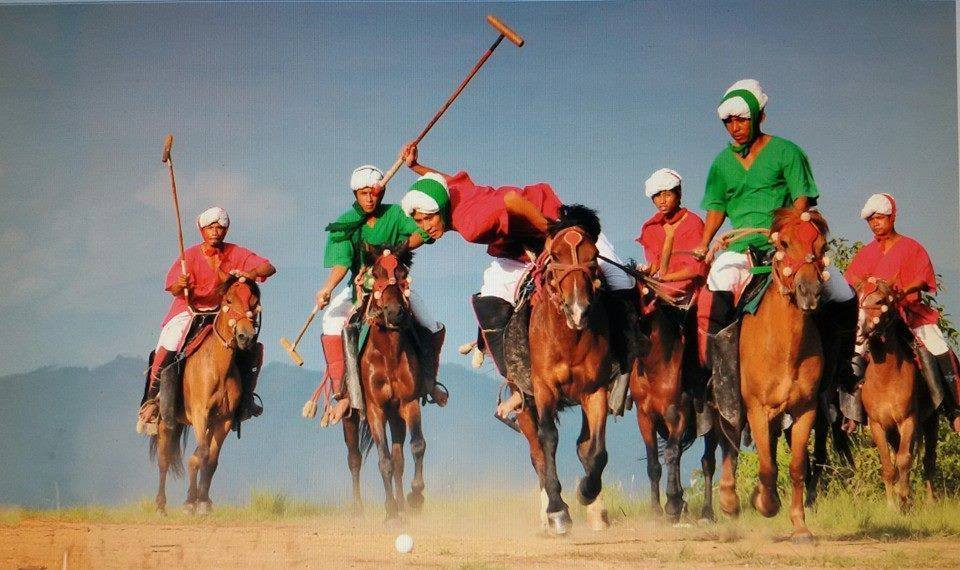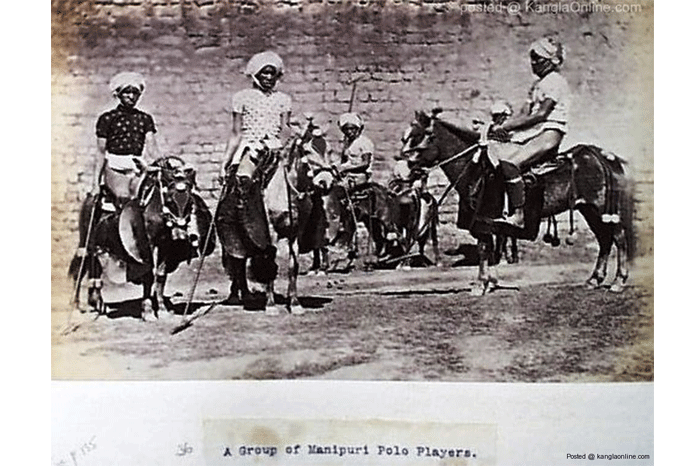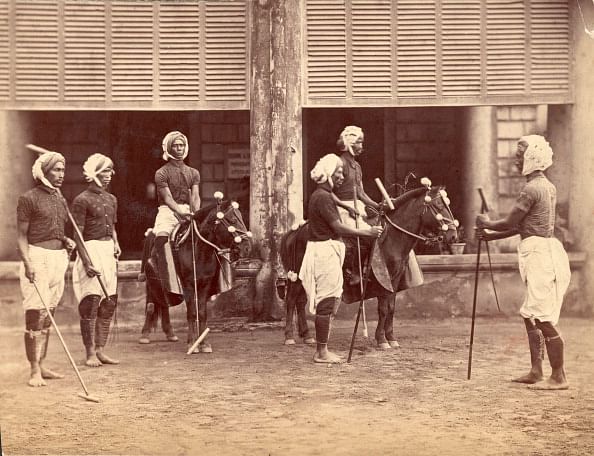
Sagol Kangjei (Manipur, India)
- Name of sport (game): Sagol Kangjei
- Place of practice (continent, state, nation):
India, Manipur
- History:
Modern-day polo originated within the small northeast Indian state of Manipur in 3100 BC, where it was played as sagol kangjei (sagol means pony and kangjei is a game of sticks). Thanks to a long and colorful history, polo in Manipur isn’t just a sport, it’s a way of life and an integral part of the state’s culture. The Manipuris have had a close relationship with the ponies since time immemorial.
Manipur has polo not just among the mortals but also has Marjing, who is considered the God of polo and features a pony as his carrier. Moreover, the Lai-Haraoba festival of the state depicts the life and times of Khori-phaba, the polo-playing god of sports. Ergo, these facts indicate that the sport has roots in the state from ancient times and the royal families of Manipuri played an important part in popularizing the sport. Taking every fact under consideration, Manipur brought noticeable change to the sport, and definitely, it’s a sports paradise.
Sagol Kangjei was never a game of the kings in Manipur; it was a king of the games played by ordinary people. Unfortunately, unplanned land-use and urbanization during the last half a century have robbed the Manipur pony of its natural habitat and the polo teams of their playing grounds. It’s become exorbitantly expensive to maintain a polo team and increasingly difficult to seek out a suitable ground to play regular matches. It’s during this context that documentation on Sagol Kangjei and its substantial contribution to modern polo is going to be of immense significance.
Source: https://anand-shinde.xyz/manipur-sagol-kangjei-the-origins-of-modern-day-polo/The origins of polo in Manipur are associated mythologically with Marjing, the God of the Chenglei tribe, to whom a structure similar to the ancient polo stick along and a ball are still offered in worship. It’s steeped so deep into the culture and folklore of Manipur that sequences in festivals are dedicated to the game – one of the most prominent examples would be the Lai Haraoba Festival in which there is a sequence dealing with the search of bride (Lai Nupi Thiba) on the part of Maibi (Priestess) with the Polo stick in hand.
Polo also finds its place in the literature which originates from that period, with several mythological books of Manipur like ‘Thangmeirol‘ and ‘Kangjeirol’ making references to the game.
According to ancient Meitei manuscripts like Kangjeirol (which is a treatise on Manipuri Polo), king Kangba introduced Sagol Kangjei, that is the “Polo” game. It is believed to be one of the three forms of hockey that people indulged in back in those days, the two others were Khong Kangjie (field hockey) and Mukna Kangjie (this involved wrestling and hockey together). It is mentioned in the aforementioned manuscripts that during the Ukrong Hongba festival, Kangba dribbled a bamboo root club by his walking stick on the ground. Consequently, he ordered his subjects to play this game on horseback the next day. Accordingly, his subordinate officers and common people from the province were the first to play this game.
The name Sagol Kangjei, as it suggests, is derived from the name of the king Kangba wherein Sagol means horse or pony and Kangjei means Kangba’s stick. It was also referred to by other names like ‘Kanjai-bazee’ and ‘Pulu’.
There are also references to the game of Polo between the friends of Ngonda Lairen Pakhangba, who ascended the throne of Manipur in 33 AD in the Cheitharon Kumpapa (official royal chronicle of the kings of Manipur).
According to the same set of texts, king Khagemba of Manipur introduced the game of Pana Sagol Kangjei in 1606 in his territory. This game was supposedly played between the four Panas of higher status and also between the two Panas of lesser status.
Consequently, it is also believed that around 1697 AD, King Charairongba led a team of 10 against another team which had 100 players. Astonishingly though, the former emerged victorious. Source: https://homegrown.co.in/article/803205/how-polo-went-from-being-a-sacred-manipuri-game-to-an-elite-sport
Source: https://homegrown.co.in/article/803205/how-polo-went-from-being-a-sacred-manipuri-game-to-an-elite-sportIt was the 19th century, after the Sepoy Mutiny of 1857 that Joseph Sherer, a lieutenant in the Indian Army, was posted to Assam’s Cachar. It was in Silchar that he was first introduced to the game. The enthusiasm exhibited by Sherer has been described as exemplary. It is said that the Raja of Manipur explained to Sherer that Manipuris had been playing the sport for more than two thousand years. In fact, it was the aberration of one of the ancient names of the game -‘Pulu’, referring to the wooden ball that it was played with, that was adopted by Sherer and his contemporaries while popularizing the game in the West.
In 1859, Sherer – later acknowledged as the father of English Polo – set up the Silchar Polo Club with seven other founding members, namely, James Abernethy, Arthur Brownlow, James Davidson, Ernst Echardt, Julius Sandeman, A. Stuart and W. Walker. They indulged in weekly games with the locals, played in the traditional open spaces with small ponies. The first rules were formulated in 1863. Source: https://www.sportskeeda.com/polo/from-sagol-kangjei-to-polo-recording-the-evolution-of-the-game-in-manipur
Source: https://www.sportskeeda.com/polo/from-sagol-kangjei-to-polo-recording-the-evolution-of-the-game-in-manipurIt is not surprising thus, that the oldest polo ground in the world is the Imphal Polo Ground.
The game expanded to other parts of the country after this, most notably to Kolkata and parts of erstwhile East Bengal. Subsequently the British took the game to their own country and in 1872, Captain Francis Herbert established the first Polo Club in England at Clytha Park, near Abergavenny.
Amongst other British people who reached out to Manipur to encourage the game was Lord Curzon, the then Viceroy of India who witnessed a match at the historic Imphal Polo ground in 1901. The game also finds a place in Curzon’s memoirs (The Viceroy’s Notebook).
Over the years, Polo has widely been acknowledged as a global sport, with more than 80 countries worldwide where the sport is currently played in. In fact it was also an Olympic sport from 1900 to 1936.
Source: https://www.sportskeeda.com/polo/from-sagol-kangjei-to-polo-recording-the-evolution-of-the-game-in-manipur - Description:
Teams consisting of 7 members each are a part of this game. Each player rides a pony of 4 to 5 feet in height. The field is rectangular in shape with dimensions of 210 yards in length and 100 yards in width. There is no goal post and the player has to hit the ball with the stick. The stick is made of cane having a narrow angled wooden head fixed at the lower end. The ball (the kangdrum) which is white in color is 14 inches in circumference and is made of bamboo root. Another important aspect which is widely believed is that the Meiteis Pony played an important role. It has a unique quality and without it, the game cannot be played.
Each player takes a specific position on the field which is as followed:
PUN- Ngakchun (Full Back)
PUN- Ngakchun (Half Back)
PULLUK (Left Wing)
LANGJEI (Centre)
PULLUK (Right Wing)
PUN JEN (Inne)
PUN-JENCHUN (Inner)
All the players wear a white dhoti which is tucked in above their knees and a head guard or a big white turban which is held by khadangchet that is a chin strap which protects their calvae. Usually, no footwear is worn and the ankles are covered khunningkhang which is a piece of leather cloth. Leg guards (khongyom) are worn below the knee.
Source: https://www.chaseyoursport.com/Indian-Sports/Sagol-Kangjei-The-Traditional-Manipuri-Polo/1070Rules:
(A). The GROUND is 300 yards long, 160 yards wide if boarded, 200 yards wide if unboarded. The goal posts are 8 yards apart.
(B). DURATION OF THE PLAY. The full game is 8 chukkas, but often in club matches 4 or 6 chukkas are played. Each chukka is timed to last 7 mins, then a bell is rung, but the game goes on until the ball goes out of play, or for another 30 secs when the bell is rung again, the chukka ends where the ball is. The clock is stopped between the umpire's whistle to stop the play and the whistle to start play (eg.ball out of play, foul etc.). There are intervals of 3 mins between chukkas and 5 mins at half time. Ends are changed at every goal scored - this has been found fairest when there is a wind.
(C). HANDICAPS. Each player is handicapped (on a 4-6 chukka basis) from -2 up to 10 goals (the top professional players). The aggregate handicap of the FOUR PLAYERS in a team is the team handicap. In handicap tournaments the number of goals start is obtained by multiplying the difference between the two teams' handicaps by the number of chukkas and dividing by 6, any fraction counting a half a goal.
(D). PONIES can play two chukkas in an afternoon with a rest of at least one chukka in between. There is no limit to the height of ponies.
(E). FOULS - (i). player following the ball on its exact line has the Right of Way over all other players. Any other player who crosses the player on the right of way close enough to be dangerous commits a foul. Penalties vary according to the degree of danger and closeness of the cross. (ii). No player may hook an opponent's stick unless he is on the same side of the opponent's pony as the ball. (iii). Dangerous play or rough handling is not allowed - a player may ride an opponent off, but must not charge in at an angle.
(F). PENALTIES. The following penalties may be given. (i). A goal is given if the cross is dangerous or deliberate in the vicinity of the goal. The ball is then thrown in 10 yds in front of the goal without ends being changed. (ii). Free hit from 30 yds opposite the centre of the goal - defenders to be behind the back line and outside the goal posts but must not ride through when the ball is hit. (iii). Free hit from 40 yds, same conditions as (ii). (iv). Free hit from 60 yds. Defenders to be 30 yds from ball. (v). Free hit from the centre of the ground, none of the defending side to be nearer than 30 yds when the ball is hit. (vi).Free hit from spot where the foul took place, no defender to be nearer than 30 yds.Corners are not taken as in Association Football - instead, a free hit is given 60 yds from the goal from a spot opposite where the ball was hit behind the line, none of the defending side to be nearer than 30 yds.
Source: https://themanipurpage.tripod.com/history/sagolkangjei.html - Current status:
Practiced.
This is a seasonal game and is played in the month of Mera that is September to October and it ends in the month of Ingen which depicts the months of June and July. - Sources of information :
Articles
https://homegrown.co.in/article/803205/how-polo-went-from-being-a-sacred-manipuri-game-to-an-elite-sport
https://themanipurpage.tripod.com/history/sagolkangjei.htmlVideo
https://www.youtube.com/watch?v=xVau1Ex8C_U
https://www.youtube.com/watch?v=XcEjiEfNnog
https://www.youtube.com/watch?v=mssGe1RDTEYSource of photos in this article:
https://anand-shinde.xyz/manipur-sagol-kangjei-the-origins-of-modern-day-polo/
http://www.e-pao.net/epGallery.asp?id=16&src=Sports/IndigenousGames/SangaiFestPanaKangjei20131128_2
https://www.chaseyoursport.com/Indian-Sports/Sagol-Kangjei-The-Traditional-Manipuri-Polo/1070
https://www.sportskeeda.com/polo/from-sagol-kangjei-to-polo-recording-the-evolution-of-the-game-in-manipur
https://homegrown.co.in/article/803205/how-polo-went-from-being-a-sacred-manipuri-game-to-an-elite-sport
https://www.manipuronline.in/about/sports
https://www.thehindu.com/news/national/other-states/manipur-gets-back-on-the-horse/article30770325.ece - Gallery:

